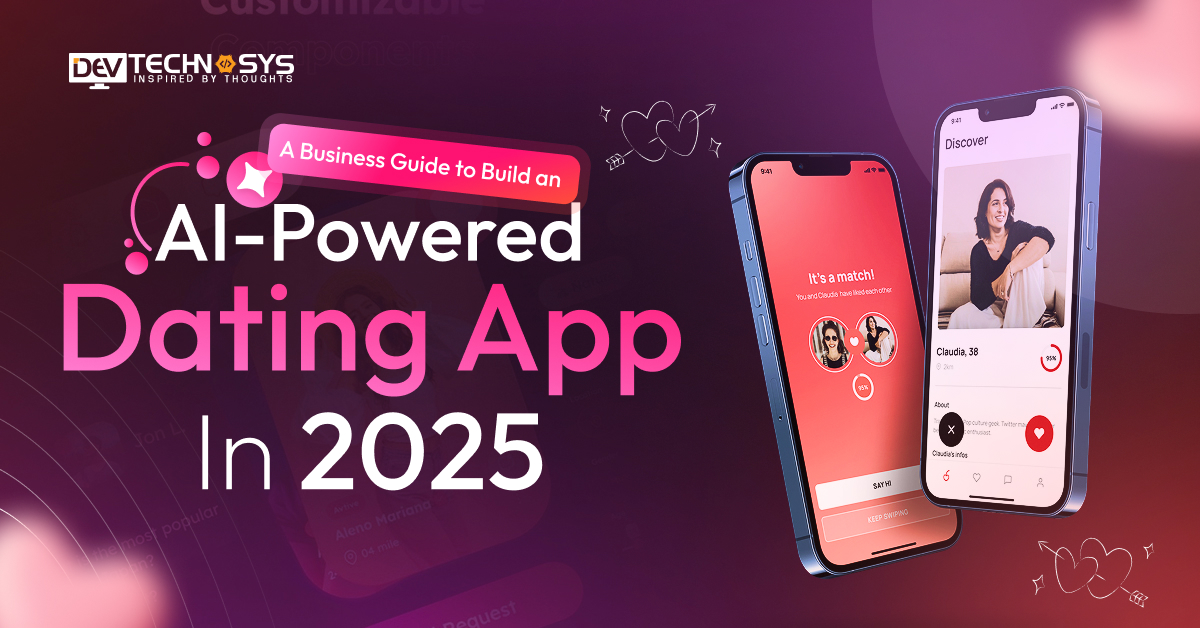Artificial intelligence, or AI, is at the forefront of the fast-changing urban mobility scenario. Intelligent, data-driven platforms that provide previously unheard-of efficiency and user experience are replacing traditional taxi services. Consider a taxi journey where demand is accurately forecasted, routing is optimized in real-time, and safety is improved by ongoing monitoring. This is not a general idea; rather, it is the AI-powered present and future of the taxi industry. This blog examines how AI is revolutionizing all aspects of taxi app development, including dynamic pricing, intelligent dispatch, and personalized user experiences, paving the way for a more intelligent, efficient, and fiercely competitive urban transportation industry.
Introduction: The Rise of AI in Taxi App Innovation
AI is redefining the taxi sector by turning conventional ride-hailing applications into smart, user-focused systems. AI technologies are simplifying operations, improving safety, and increasing efficiency in a variety of ways, from forecasting demand to optimizing routes and customizing user experiences. The travel app development solutions in urban transportation are being ushered in by the growing reliance of taxi services on AI to obtain a competitive advantage, boost profitability, and provide smooth experiences for both drivers and passengers as competition increases.
Why Does the Traditional Taxi Business Need Disruption?
To remain competitive in the modern digital environment, traditional cab services need to welcome disruption. Modernizing operations, improving customer satisfaction, and promoting sustainable growth can all be achieved by utilizing AI and technology.
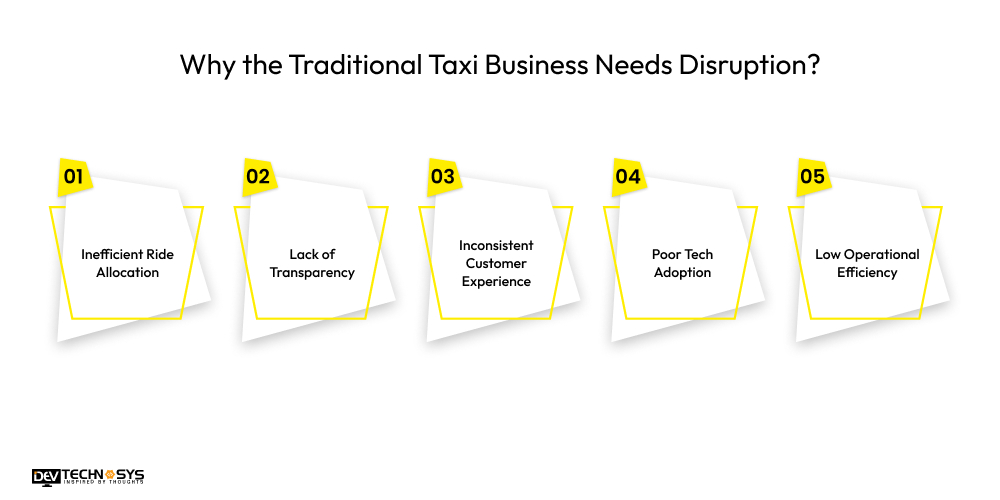
Inefficient Ride Allocation
Longer wait times and less efficient driver routes are the results of traditional taxi systems, which frequently rely on manual dispatching or street hailing. Drivers lose money as a result of this, as well as fuel waste and idle time.
Lack of Transparency
Generally speaking, traditional taxis don’t provide clear communication, live tracking, or transparent pricing. Both drivers and passengers become frustrated by this lack of transparency, which erodes confidence and dependability.
Inconsistent Customer Experience
Traditional taxis lack uniformity in terms of service quality, car condition, and driver conduct. The lack of clarity regarding the quality of service provided to riders may discourage them from using the service again.
Poor Tech Adoption
In contrast to app-based ride services, the majority of legacy taxi companies fall behind in implementing digital payments, mobile booking, or AI-driven solutions.
Low Operational Efficiency
Traditional taxi fleets find it difficult to forecast trends, handle supply-demand imbalances, or scale efficiently without real-time data and analytics, which leads to missed opportunities and increased operating expenses.
How AI Is Fueling the Next Generation of Taxi Apps?
With these taxi booking app development, AI is transforming urban mobility into a more intelligent, secure, and responsive ecosystem for all parties involved—it’s not simply making taxi applications work better.

Smarter Demand Prediction
To precisely forecast demand, AI examines past data, the weather, events, and user behavior. This guarantees improved driver availability in areas with heavy traffic, cutting down on passenger wait times and raising driver compensation.
Route Optimization in Real Time
In order to provide the most effective routes, AI-driven navigation systems evaluate real-time traffic, road conditions, and accidents. This improves the whole journey experience while cutting down on travel time and fuel usage.
Dynamic Pricing Models
Flexible fare systems that modify pricing according to variables like demand, time, and traffic are made possible by AI. This maximizes driver income during peak hours and guarantees fair pricing for passengers.
Enhanced User Personalization
With personalized ride recommendations, favorite drivers, and loyalty incentives, AI personalizes app experiences, giving users a more convenient and personalized trip experience.
Fraud Detection and Safety Intelligence
AI keeps an eye on payment and ride patterns to identify any suspect or fraudulent activities. Instantly notifying users of unexpected transport requests or departures from typical routes also increases safety.
Key AI Technologies Powering Smart Taxi Apps
With the help of AI development services in UAE, modern taxi applications do more than just arrange a ride; they also make the process quicker, safer, and more intelligent. The main AI systems causing this change are as follows:
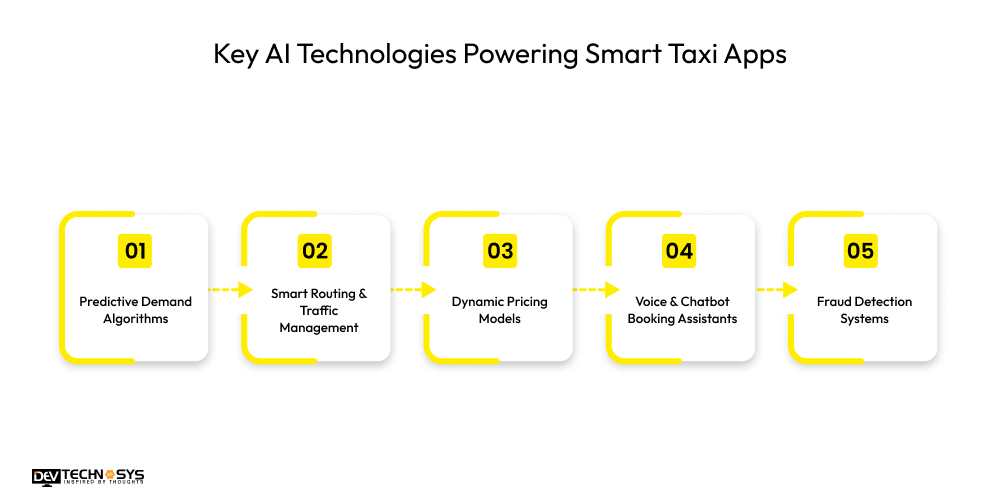
1. Predictive Demand Algorithms
To predict ride demand, AI-powered predictive models examine past ride data, time, location, weather, and events. This lowers wait times and increases driver income by enabling platforms to place drivers in areas with high demand even before consumers book rides.
2. Smart Routing & Traffic Management
Predictive analytics and real-time traffic data are used by AI-integrated routing systems to identify the quickest and most fuel-efficient routes. These technologies help drivers avoid delays and increase trip accuracy by taking into account weather, accidents, road closures, and traffic congestion.
3. Models of Dynamic Pricing
Real-time variables, including traffic, the time of day, local events, and the demand-supply ratio, are used by machine learning to dynamically modify fares. These dynamic pricing models guarantee availability for passengers during peak hours while striking a balance between drivers’ income.
4. Voice & Chatbot Booking Assistants
With the help of an AI Chatbot development company, integrating AI voice assistants and chatbots makes reservations easier. By integrating NLP (Natural Language Processing), they improve accessibility and user convenience by enabling users to schedule trips, inquire about the status of their rides, or modify destinations using conversational, natural language.
5. Fraud Detection Systems
Artificial intelligence (AI) technologies are essential for spotting fraudulent activity like phony transportation reservations, fraudulent payments, and cooperation between drivers and passengers. They guard against money loss for consumers and the platform by analyzing odd behavior patterns and flagging suspicious activity instantly.
Features That Make AI-Powered Taxi Apps Stand Out
Now, the time has come when you must know about the features of AI-powered taxi app development. In this section, we have compiled a list of features that you must know about with three different panels.

1. Rider-Focused Features
One-Tap Ride Booking
AI suggests frequent routes instantly, enabling users to book rides quickly with minimal input based on past behavior.
Real-Time Driver Tracking
AI-powered GPS tracking allows riders to monitor their driver’s live location for a safer, transparent travel experience.
Fare Estimation
Machine learning algorithms calculate real-time estimated fares using distance, traffic, and demand conditions before booking.
ETA Accuracy
AI enhances ETA precision by analyzing live traffic patterns, driver speed, and road conditions dynamically.
Voice-Powered Booking
Natural Language Processing enables users to book rides via voice, making the app more accessible and user-friendly.
Ride Scheduling
AI lets users pre-book rides based on predictive availability and expected traffic trends at chosen times.
Dynamic Ride Suggestions
Smart systems recommend ride options like carpooling or premium based on budget, timing, and user history.
AI Chat Support
Intelligent chatbots handle user queries, complaints, and support requests 24/7 with quick, relevant responses.
Safety Notifications
AI triggers alerts to riders when routes deviate unexpectedly, ensuring greater journey transparency and security.
Rating & Feedback Insights
AI compiles driver feedback trends to improve service quality and personalize future ride experiences.
2. Driver-Centric Features
Predictive Ride Demand
AI identifies high-demand zones and times, guiding drivers to areas with greater earning opportunities.
Smart Navigation Assistance
Real-time route optimization ensures drivers reach destinations faster using live traffic and accident data.
Driver Performance Analytics
AI monitors driving behavior, speed, and ratings to generate insights for performance improvements and incentives.
Fuel-Efficient Routing
Machine learning recommends fuel-saving routes, reducing operational costs for drivers.
Auto Accept Rides
AI enables auto-accepting ride requests in high-demand areas to minimize driver idle time.
Income Forecasting
AI tools project earnings based on historical trends, weather, demand surges, and competition.
Flexible Shift Recommendations
Smart scheduling suggests optimal working hours based on driver availability and market activity.
In-App Driver Assistant
AI assistants help drivers with live alerts, navigation updates, and quick replies to rider messages.
Fraud Alert System
AI flags suspicious ride requests or unusual payment behaviors to protect drivers from scams.
Driver Retention Insights
AI analyzes engagement and earnings trends to suggest retention strategies like bonuses and rest breaks.
3. Admin/Business-Centric Features
Dynamic Pricing Engine
AI adjusts prices in real-time based on demand, traffic, and weather to maximize platform profitability.
Fleet Utilization Monitoring
If you create a taxi booking app, AI tracks vehicle usage patterns to ensure optimum fleet deployment and reduce downtime.
Smart Dispatch System
AI assigns the most suitable driver to each request based on distance, rating, and vehicle type.
Customer Segmentation
Machine learning clusters users into segments for targeted promotions, loyalty programs, and tailored experiences.
Fraud Detection & Prevention
AI identifies anomalies in ride or payment patterns to prevent abuse and financial loss.
Churn Prediction Models
Predictive algorithms identify users likely to stop using the app, enabling timely re-engagement campaigns.
Marketing Automation
AI recommends and runs personalized campaigns based on user behavior, location, and ride history.
Revenue Forecasting
AI projects revenue growth using historical data, market trends, and seasonal patterns for better planning.
Driver Onboarding Automation
AI streamlines the driver verification process using document recognition and behavior analysis.
Regulatory Compliance Alerts
AI monitors operations and triggers alerts for licensing, emissions, or safety compliance violations.
Real-World Use Cases: How AI Is Driving Results for Taxi Startups
By increasing productivity, facilitating better decision-making, and boosting user experience, artificial intelligence is transforming the taxi sector. The following ten real-world examples show how artificial intelligence development in Dubai is helping cab startups worldwide achieve measurable outcomes:
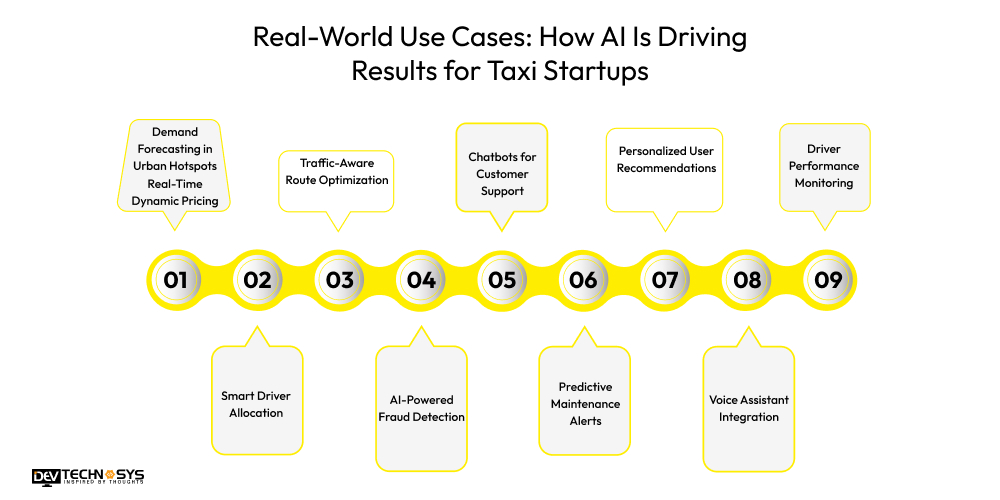
Demand Forecasting in Urban Hotspots
By examining past ride data, regional events, and meteorological conditions, AI helps businesses forecast ride demand in certain regions. Startups like Ola and Lyft, for example, use this to place drivers in areas with high demand before peak hours, which shortens rider wait times and boosts driver income.
Real-Time Dynamic Pricing
AI-driven surge pricing algorithms are used by taxi apps such as Uber to instantly modify charges in response to demand, traffic, and driver availability. This boosts platform profitability and keeps rides available during busy times.
Smart Driver Allocation
By taking into account factors like location, anticipated arrival times, and driver ratings, Smart Driver Allocation AI pairs riders with the best neighboring drivers. Intelligent dispatch systems are used by startups such as Bolt to minimize cancellations and maximize driver-rider pairing.
Traffic-Aware Route Optimization
AI-based navigation is used by apps like Grab to provide the quickest routes by taking into account real-time traffic, road closures, and construction updates. This shortens travel time and increases client pleasure.
AI-Powered Fraud Detection
AI is integrated in taxi booking app development in Dubai to identify questionable practices, including fraudulent payments, phony reservations, or frequent cancellations. By using pattern recognition to identify abnormalities, these models shield the platform and its users from monetary losses.
Chatbots for Customer Support
Startups use AI chatbots to answer frequently asked questions by drivers and passengers, like misplaced property or payment problems. Platforms like Careem deploy these round-the-clock bots to increase user happiness and lower operating costs.
Predictive Maintenance Alerts
AI is being used by certain taxi firms to track vehicle data and anticipate mechanical issues before they arise. This helps startups maintain excellent service quality without unexpected disruptions and reduces downtime.
Personalized User Recommendations
AI uses user history to provide targeted discounts, preferred car types, and customized ride options. Apps like Didi and Lyft demonstrate how this strategy increases rider loyalty and engagement.
Voice Assistant Integration
AI voice assistants are included into apps to enable hands-free booking, which is particularly helpful for users who are pressed for time or who are blind. Uber has investigated this with Google Assistant, increasing accessibility to ride-hailing.
Driver Performance Monitoring
AI systems create performance scores by analyzing driver behavior, including braking, acceleration, and consumer input. These analytics are used by taxi companies to award top drivers and offer tutoring when necessary.
5 Stages of AI-Powered Taxi App Development
A methodical, multi-phase procedure is required to create an AI-powered taxi app that guarantees a seamless and perceptive user experience. A seasoned taxi app development in UAE business usually takes the following approach:
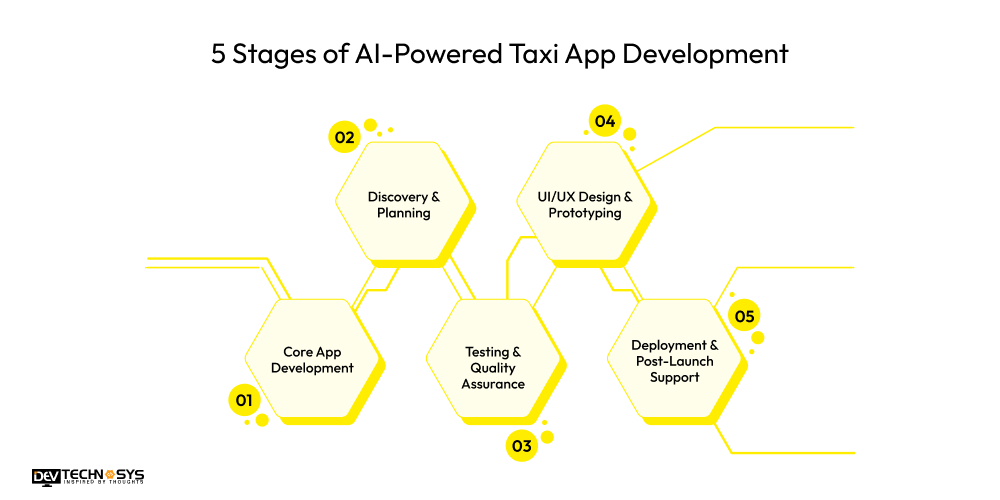
1. Discovery & Planning
Let’s start the AI-powered taxi app development process. Understanding your target market, business strategy, and essential needs is the main goal of this first phase. The mobile app development company analyzes the competition, specifies important AI features such as dynamic pricing or predicting demand, and provides a technological roadmap, budget, and schedule.
2. UI/UX Design & Prototyping
Move to the second stage to develop a taxi booking app, for both rider and driver apps, an easy-to-use interface is designed. The business considers usability and accessibility when developing interactive prototypes and wireframes. Design teams create flows for AI-enabled products like voice booking and chatbots and incorporate user feedback loops.
3. Core App Development
At this point, the AI-powered taxi app development team incorporates machine learning models, payment gateways, AI APIs, GPS, and the frontend and backend. Hire taxi app developers to use tools like TensorFlow or AWS AI services, AI modules like demand forecasting, fraud detection, and route optimization are integrated straight into the design.
4. Testing & Quality Assurance
In the fourth stage to create a taxi booking app, extensive testing is done on various platforms and devices. Particular attention is paid to AI modules, examining their capacity for fraud detection, personalization logic, and prediction accuracy. Tests for load, security, and performance ensure the program is dependable and scalable.
5. Deployment & Post-Launch Support
Hire a professional iOS app development company in Dubai to release the app on the specific platform and app stores. To guarantee ongoing development and customer satisfaction, the AI-powered taxi app development business provides post-launch support, tracks AI performance, and optimizes features using real-time data.
Benefits of Using AI in Taxi App Development in Dubai
AI integration makes taxi apps smarter, more flexible, and more profitable, laying the groundwork for expandable and user-friendly urban transportation options.
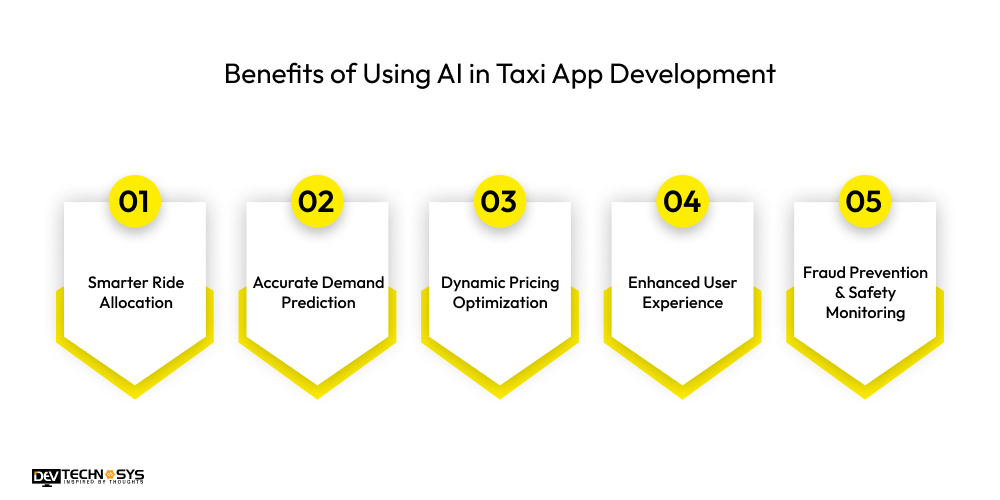
Smarter Ride Allocation
By evaluating factors like availability, distance, traffic, and driver ratings, AI enhances the way drivers and riders are matched. Higher client happiness, fewer cancellations, and speedier pickups are the outcomes of this.
Accurate Demand Prediction
AI predicts peak demand times and locations by examining local events, historical data, and weather patterns. By minimizing idle time and increasing revenue, this aids in the smart deployment of drivers.
Dynamic Pricing Optimization
AI-driven pricing instantly modifies fares according on availability, demand, and traffic. In addition to increasing drivers’ earnings during peak hours, it guarantees riders fair pricing.
Improved User Experience
With features like voice-based booking, predictive ride recommendations, and real-time customer service through chatbots, AI personalizes app experiences and makes them more user-friendly and interesting.
Fraud Prevention & Safety Monitoring
AI can identify suspect activity like fraudulent payments, phony accounts, or risky ride patterns. By setting off real-time alarms, it contributes to the preservation of a safe environment for both drivers and passengers.
Challenges and How to Overcome Them with the Right AI Strategy
With the right AI strategy, taxi startups can solve core challenges, boost operational efficiency, and create user-first experiences that drive long-term growth.
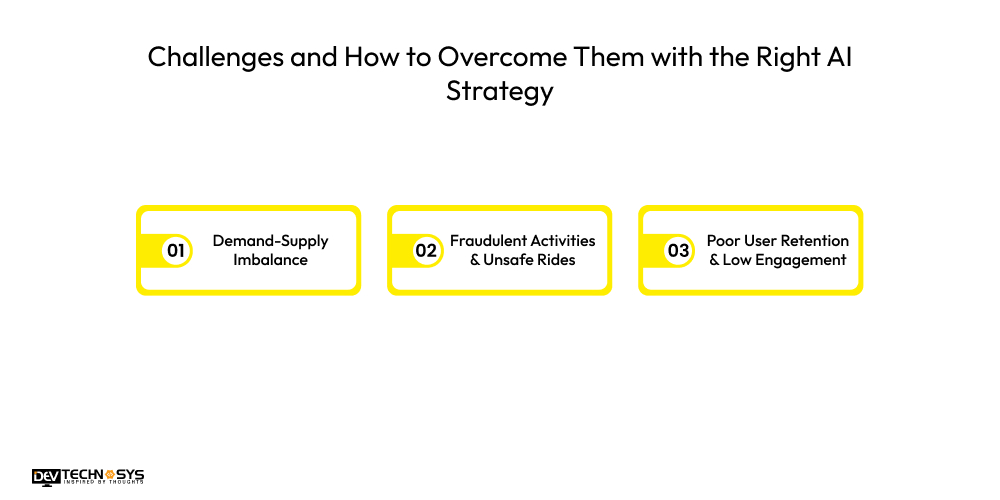
1. Challenge: Demand-Supply Imbalance
Many taxi apps struggle to match rider demand with driver availability during peak hours or in underserved areas, leading to long wait times or service unavailability.
AI Strategy:
Implement predictive demand algorithms that analyze historical data, time, location, and events to forecast high-demand zones. By proactively deploying drivers to those areas, apps can reduce idle time and ensure consistent availability.
2. Challenge: Fraudulent Activities & Unsafe Rides
Taxi platforms face issues like fake bookings, payment fraud, or unsafe rider-driver interactions, which can harm brand trust and user retention.
AI Strategy:
Use AI-driven fraud detection systems that identify unusual patterns in real-time, such as repeated cancellations, suspicious payment methods, or route deviations. Integrate AI safety monitoring tools that send alerts for abnormal ride behavior and enable emergency features for riders and drivers.
3. Challenge: Poor User Retention & Low Engagement
Generic app experiences and lack of personalization often result in users switching to competitors or abandoning the app altogether.
AI Strategy:
Leverage machine learning to personalize ride suggestions, offer relevant discounts, and recommend ride types based on user behavior. Use AI chatbots to provide 24/7 support, enhancing satisfaction and loyalty.
Tech Stack & Tools for Building an AI-Integrated Taxi App
Component |
Technology/Tool |
Purpose |
| Frontend (Mobile/Web) | Flutter, React Native, Swift (iOS), Kotlin (Android) | Build user and driver apps with cross-platform or native performance |
| Backend Development | Node.js, Django, Ruby on Rails, Express.js | Server-side logic, APIs, and business operations |
| AI/ML Models | TensorFlow, PyTorch, Scikit-learn, Amazon SageMaker | Build and train models for demand prediction, pricing, and personalization |
| Chatbot & NLP | Dialogflow, IBM Watson, Rasa, OpenAI API | Voice/chatbot assistants for bookings and support |
| Maps & Routing | Google Maps API, Mapbox, HERE Technologies | Real-time navigation, ETA, and route optimization |
| Payment Gateway | Stripe, Razorpay, PayPal, Braintree | Secure in-app transactions and digital payments |
| Push Notifications | Firebase Cloud Messaging (FCM), OneSignal | Alerts, ride updates, and promotions |
| Database | PostgreSQL, MongoDB, Firebase Realtime DB | Store user profiles, rides, payments, and feedback |
| Cloud Hosting | AWS, Google Cloud, Microsoft Azure | Scalable infrastructure and AI model deployment |
| Analytics & Monitoring | Mixpanel, Google Analytics, Datadog, Sentry | Track usage, behavior, app performance, and error reporting |
Cost Factors: What Goes Into Developing a Smart Taxi App with AI
The cost to build a Taxi app with AI requires a number of expensive elements. Businesses may ensure high performance and innovation while successfully planning their budgets by having a thorough understanding of these elements.
1. UI/UX Design of Apps
It is essential to design an interface that is easy to use for administrators, drivers, and riders. Complexity, features like voice booking, and personalized animations all affect price. A well-designed user interface increases client retention and enhances usefulness.
2. Integration of AI
The cost is greatly impacted by integrating AI capabilities like chatbots, dynamic pricing, fraud detection, and predicting demand. Using platforms like TensorFlow or AWS AI services to develop and train machine learning models increases resource consumption and technical complexity.
3. Functionality & Feature Set
The cost of develop a mobile app increases with the sophistication of its features, such as automatic dispatch, in-app voice assistants, real-time tracking, and safety alerts. The cost build a taxi booking app is additionally increased by seamless payments and multilingual support.
4. Infrastructure Backend
A secure, scalable, and AI-ready backend architecture is crucial. Expenses include cloud hosting, real-time analytics, database setup, API development, and data pipelines for effective ride and user data processing.
5. Support for Platforms (Web, Android, and iOS)
The number of AI-powered taxi app development hours increases when the software is developed for numerous platforms. Although native programming frequently yields greater performance, cross-platform frameworks like Flutter can lower expenses.
6. Quality Assurance & Testing
It is essential to thoroughly test AI models, performance, security, and usability. This guarantees that the application runs without a hitch on a range of devices and environments.
7. Support & Maintenance After Launch
App upgrades, bug repairs, AI model improvement, and infrastructure expansion in response to user growth are examples of ongoing cost to maintain an app.
Cost Factor |
Estimated Cost Range (USD) |
| 1. UI/UX Design of Apps | $1,000 – $4,000 |
| 2. Integration of AI | $2,000 – $6,000 |
| 3. Functionality & Feature Set | $2,000 – $7,000 |
| 4. Infrastructure Backend | $1,500 – $5,000 |
| 5. Platform Support (Web/Android/iOS) | $1,500 – $4,500 |
| 6. Quality Assurance & Testing | $800 – $2,000 |
| 7. Support & Maintenance (1st Year) | $1,000 – $3,500 |
| Total Estimated Cost | $8,000 – $30,000+ |
The cost to build a taxi app with AI might vary from $8,000 to $30,000+ on average, depending on the features, complexity, and experience of the development partner.
What to Look for When Selecting the Best AI Development Partner?
To build a taxi booking app, it requires selecting the right AI development partner. Seek out post-launch support, a robust portfolio, experience with mobility solutions, and knowledge of AI technology. Innovation, security, and scalability are qualities that the ideal partner should provide. Select Dev Technosys; we are the ideal partner for your AI-powered taxi app development since we combine extensive domain knowledge, cutting-edge AI capabilities, and a track record of success.
Future Trends: What’s Next for AI in the Ride-Hailing Industry
The ride-hailing sector is expected to become more intelligent, individualized, and efficient than before as AI develops further.
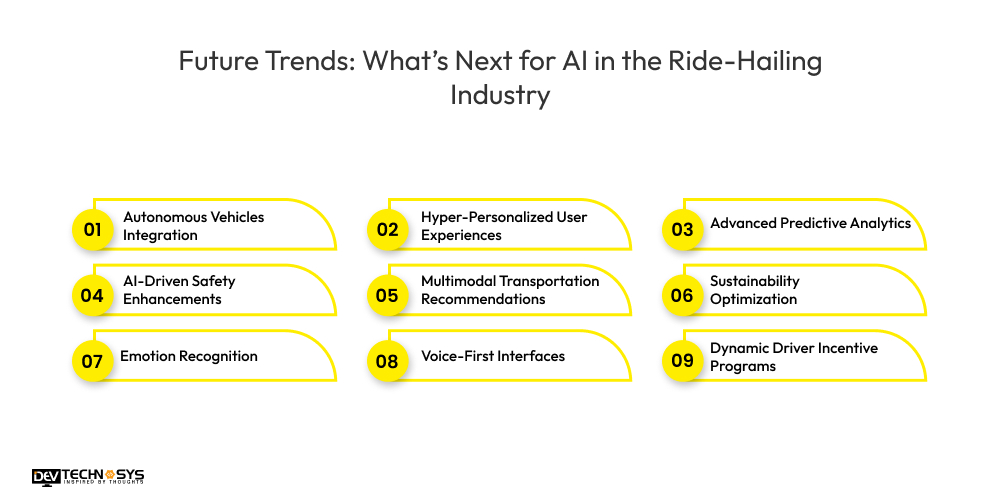
Autonomous Vehicles Integration
Self-driving taxis powered by AI will minimize human error, optimize routes, and save long-term operating expenses.
Hyper-Personalized User Experiences
AI will provide personalized ride recommendations, loyalty benefits, and customized communications based on rider behavior and preferences.
Advanced Predictive Analytics
In addition to ride demand, Advanced Predictive Analytics AI will forecast driver availability, vehicle maintenance requirements, and passenger attrition.
AI-Driven Safety Enhancements
AI-powered real-time video and audio analysis will increase safety by quickly identifying instances of aggressive driving or distress.
Multimodal Transportation Recommendations
AI will create seamless urban mobility solutions by recommending the best mixes of rides, bikes, scooters, or public transportation.
Sustainability Optimization
AI will direct fleet management and route selection to lower fuel usage and promote environmentally friendly transportation objectives.
Emotion Recognition
New AI technologies could evaluate rider happiness in real time by interpreting facial expressions or voice tones.
Voice-First Interfaces
Voice booking driven by AI will advance to accommodate increasingly complicated requests, increasing the usability and accessibility of apps.
Dynamic Driver Incentive Programs
AI will develop performance-based incentive systems in real time to boost service quality and driver motivation.
Conclusion: Should You Invest in an AI-Powered Taxi App Now?
Of course. AI-powered taxi apps provide a competitive edge through more intelligent operations, predictive services, and customized experiences as urban mobility changes quickly and customer expectations rise. The market for effective, technologically advanced ride-hailing services is expanding, and early AI adopters stand to benefit greatly in terms of customer acquisition, retention, and profitability. The moment is right to invest in AI tools as they become more widely available and potent. Collaborate with Dev Technosys to transform your idea into an intelligent, scalable taxi app that sets the standard for mobility in the future.
FAQ
1. What Is A Taxi App With Ai Capabilities?
For a more intelligent, smooth travel experience, an AI-powered taxi app optimizes ride matching, route planning, pricing, and customer service using artificial intelligence.
2. How Does Ai Increase The Effectiveness Of Taxi Apps?
By anticipating demand, cutting wait times, streamlining routes, and automating pricing and dispatch, artificial intelligence (AI) improves efficiency, which improves resource use and raises customer satisfaction.
3. Does Integrating Ai Into Taxi Apps Cost Money?
Although costs differ according to features and complexity, integrating AI improves operations, increases user engagement, and decreases manual intervention, all of which increase long-term profits.
4. Is It Possible For Ai To Stop Fraud In Taxi Apps?
Indeed, by examining ride patterns and user behavior, AI can identify suspect activity such as fraudulent payments or phony reservations, improving user and driver safety.
5. Why Design A Taxi App Using Ai Now?
The use of AI in mobility is growing. Investing today provides you a competitive advantage, enhances the quality of your services, and sets up your app for future technological trends like personalization and automation.







